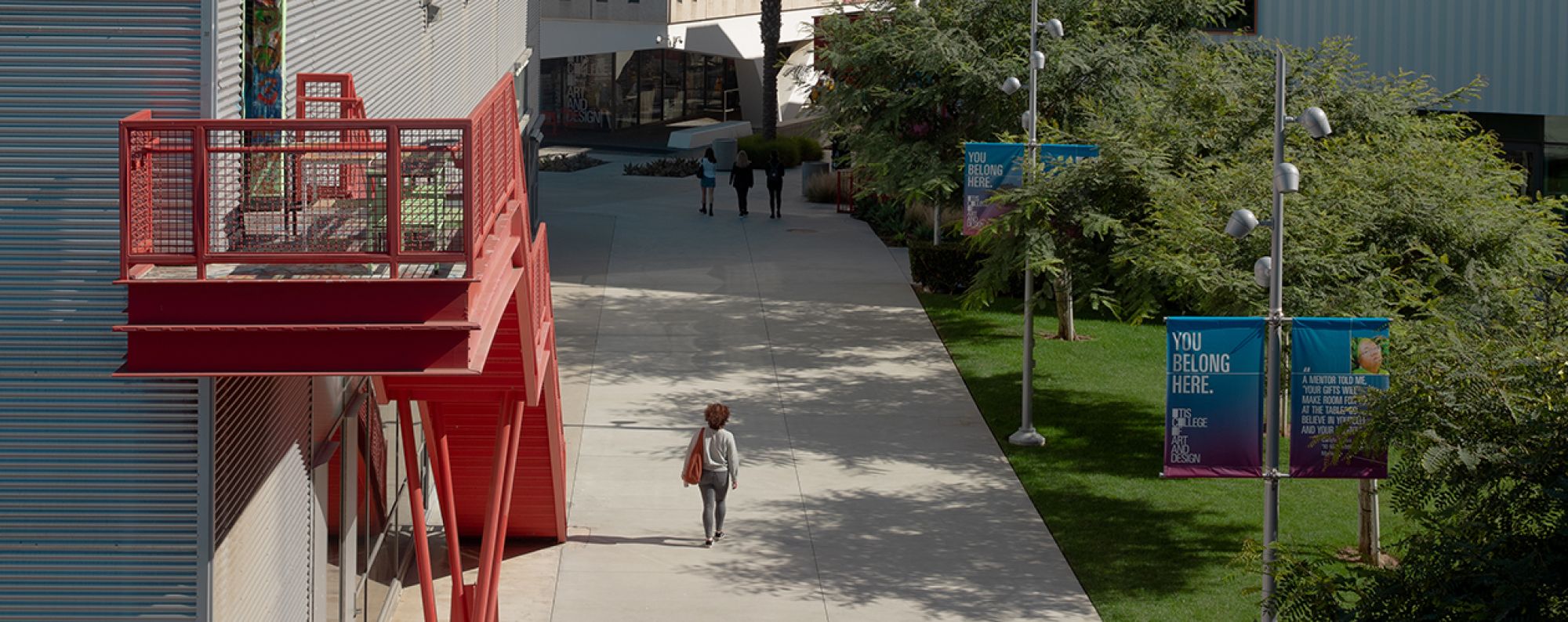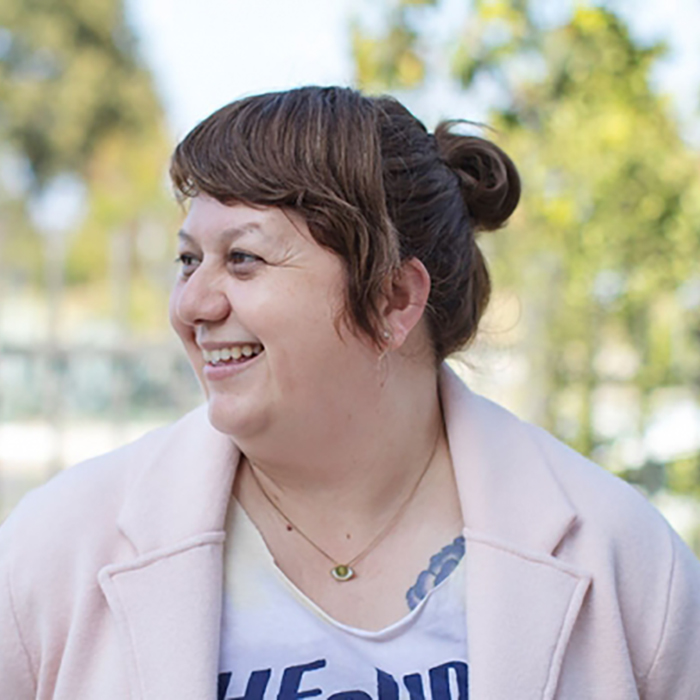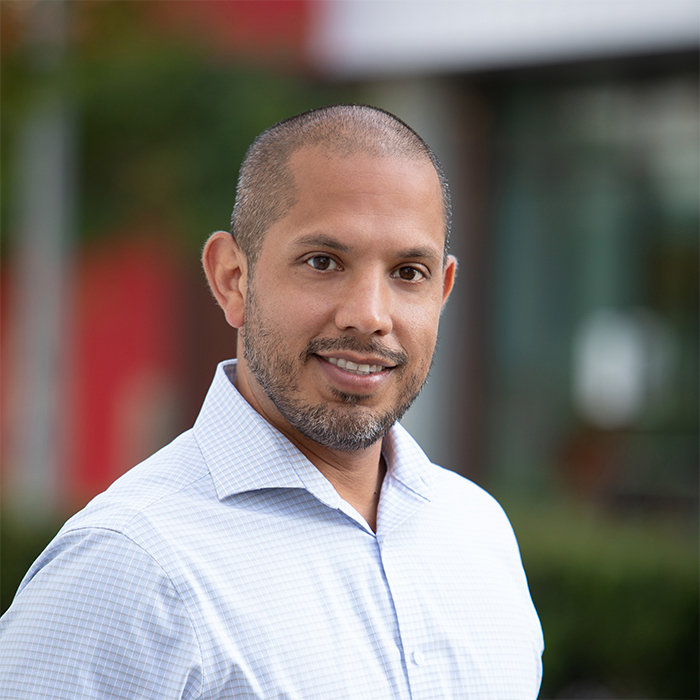A Sense of Belonging as Otis College Students Return to Campus
The “You Belong Here” campaign helped kick off the arrival of students, staff, and faculty after over a year of studying and working remotely.

Photo by Jennifer Atalla
After preparations were completed in anticipation of a return to campus this fall—after COVID precautions and guidelines were put in place, and faculty members reverted some of their classes to in-person instruction—thoughts next moved to the more emotional questions regarding this big transition. How did we feel about finally returning to campus? How did we want students to feel? The answer was simple and immediate: to remember one of Otis College’s most unique qualities that may have felt elusive during a year of remote working and studying—our strong sense of community. An idea to create a return-to-campus campaign centered around the concept of belonging began to take shape. The campaign showcased how everyone—from students to faculty to staff—are welcome at Otis and have a place within its creative community. Several alumnx shared advice for students that was showcased on banners hung around the Commons and on posters that lined hallways. A video was created featuring members of the community who shared how they feel a sense of belonging at Otis. “I think people are seen here. I think people are heard here. I think people’s work and ideas are empowered and supported and taken very seriously here,” says President Charles Hirschhorn in the video. We asked a few members of the community to expand upon their experiences at Otis and help amplify this theme of belonging.
Hazel Mandujano on the Community of Artists at Otis

“On my first day attending Otis College, I walked in with the confidence that I was in the right place. That first week, I walked out every night feeling very different and out of place.
The drive to school is where I first saw all of the different neighborhoods and cars that were giveaways that I was far from home—Wilmington, CA. The neighborhoods and cars I drove past as I got closer to Westchester got bigger and more expensive-looking, and when I walked into class I saw that I didn’t have the same or correct materials, didn’t eat the same foods, or speak the same way as many of my classmates and teachers did. It was strange—I am from Los Angeles and even though I was still in Los Angeles, it wasn’t the L.A. I knew. The people I saw working in facilities, as chefs, and as cleaning crew were who resembled my aunts, uncles, and neighbors. They were the only familiar feeling part for me until my first critique.
It was in critique and on studio days—the quiet working moments when we were all artists—that I felt like I really was in the right place, like I belonged, and I was part of the fabric of the community of artists at Otis.
Over time, I have found how much value my experience informs my role as the Director of Alumnx Relations. I believe that what unifies us all is our craft. We all share the same vulnerability and space as artists. It is in that space of making, designing, producing, thinking, iterating, evolving, failing, and succeeding that we all show up for each other and where we all belong and are equal.”
Hazel Mandujano (’03 BFA Fine Arts, ’10 MFA Graphic Design) is the Director of Alumnx Relations at Otis College.
Santoni Kina on Finding Joy, Safety, and Community
Santoni Kina is a Foundation-year student at Otis College.
Nicholas Negrete on Creating a Community of Support

“When I think about my experience with belonging in college, and when I first felt that sense of safety and affirmation, I immediately think about the Summer Transition Enrichment Program (STEP) at University of California at Santa Barbara, where I attended. STEP was a two-week summer bridge program for first-generation college students and students from low socioeconomic backgrounds to experience a pre-college engagement activity. I attended this program with 150 other students, and I immediately connected with my community of support. At the time, UC Santa Barbara was considered to be a predominately white institution (PWI), and was known as the ‘whitest UC’ out of all of the colleges in the UC system.
Orientation was an isolating experience for me and created a sense of fear and anxiety. I remember attending a new student orientation by myself because my family could not afford for all of us to attend. At the time it was about $80 to $100 per person for a two-day program, and we truly did not have $250 to $300 to spend. It was hard enough paying for my deposit just to confirm my spot at UCSB. I was one of a few students with no family at orientation and I felt completely alone, isolated, and I struggled connecting with anyone in a meaningful way. I questioned if I was in the right place, and if I truly belonged at UCSB. I wondered if this was indeed the right choice and began to plan my exit strategy to leave the college before classes even started. I felt paralyzed.
But it was there that I learned about STEP and took a chance to see if things would be any better. Not only was the program better, it was phenomenally empowering. I met students who looked like me, grew up like me, talked like me, and had similar struggles and fears. I met faculty and staff who had a similar journey and passed down their own experiences through mentorship and support. STEP was life-changing and made me believe that I could accomplish anything at UC Santa Barbara. In a sense, I felt ready for the world and I felt that my voice mattered and was valued.
As I look back at my younger self and relate it to my current role and experience serving our students at Otis College, I want to replicate a similar sense of belonging and empowerment among students from historically underrepresented backgrounds—our Black, Latinx, LGBTQ+, first-generation, and Indigenous students. Our students living with disabilities, coming from religious identities that are minoritized, and our students who may experience gender in a way that is non-binary and non-conforming. I want all of our students to feel a sense of ownership for the environment they are occupying, and to be able to connect with the community in ways that allow them to be their full authentic selves.
I want to create a ‘STEP’ experience for our students, where there is no question about whether they belong here or not. The question lies in how much they can achieve and thrive in a campus environment that fully supports them. As the Associate Vice President of Diversity, Equity, and Inclusion, I want to create a community of support, a culture of care, and a circle of empowered leaders who can raise their voices, share their experiences, and enrich the classrooms, studios, and cocurricular environments. I want our college to be one that students experience as open, affirming, empowering, identity-conscious, and one that allows for the possibilities to run wild. I want our sense of belonging to be revolutionary and impactful, and to foster a sense of joy.”
Nicholas Negrete is the Associate Vice President of Diversity, Equity, and Inclusion at Otis College.
Maddie Davis on Belonging in Every Aspect of Who You Are
Maddie Davis is a junior in the Communication Arts program at Otis College.
TeaYoun Kim-Kassor on Engendering a Sense of Belonging

“Finding the many meanings of the word ‘belonging’ has deeply imbued my life and artwork. I am originally from South Korea and have lived in Japan and the U.S. for many years. This cross-cultural experience brings me to question who I am and where I am, which leads me to another inquest, ‘Do I belong here?’—regardless of the geographic locations I have lived in the past or present. Having experiences of living and traveling in different countries taught me the importance of finding physical and psychological belongings in groups and societies. When I lived in Japan as an international student, I encountered many cultural and language barriers every day. However, reaching out to domestic and international students and being part of such groups gave me a safe space to discuss those difficulties. Having good friends who are willing to exchange varied ideas and voices held my chin up and helped me move forward.
For me, a sense of belonging begins with two steps:
1. When we welcome different thoughts and opinions and invite newcomers to participate actively, we are providing individuals with a different point of access. This accessibility relates directly to diversity and inclusion.
2. When we find ourselves embarking in a new space, with untested interactions comes a sense of openness and curiosity and active engagement.
At any moment we are all new to any given experience.
Ultimately, belonging takes work, from all parties involved. From these efforts we find ourselves in a positive place, healthy relationships, and an interwoven community. Belonging also comes with having ownership of my part in a community, and for it to thrive it takes active engagement.
In my experience, having ownership enables me to provide active contributions to the group. I want to build stronger connections and community—not because I have to, but because I want to.
I am very grateful to Otis; my new home institution supports different social identities and values employees’ insights and contributions that harness diversity. I found a meaningful sense of connection when I genuinely engaged and responded to the organization’s openness in diversity and inclusion.
Since I arrived at Otis this past June, I have been voluntarily contributing my time and effort to create professional environments that consist of inclusive practices. I have been invested in and initiated to build intentional connections with members of the Foundation department, as well as across departments, to listen and welcome opinions and perspectives into conversations. As a cross-cultural person, I am committed to the didactic value of difference and belonging.
I hope the first-year students at Otis can find a sense of new home by honoring their heritage and being respectful of others while actively strengthening a sense of community. This sincere, strong, community-building effort and thrive in academic responsibilities will create a powerful sense of belonging. As Chair of Foundation at Otis, I encourage students to think outside the box and beyond conventional wisdom’s confines and explore uncharted grounds. Let’s step forward to build a brighter future together with a sense of belonging at Otis. This environment will help all of us to create a safe space to pursue our prospects.
TeaYoun Kim-Kassor is the Chair of the Foundation department at Otis College.
Izzy de Paz on Connecting Through Differences with Other Students
Izzy de Paz is a senior in the Digital Media program at Otis College.

